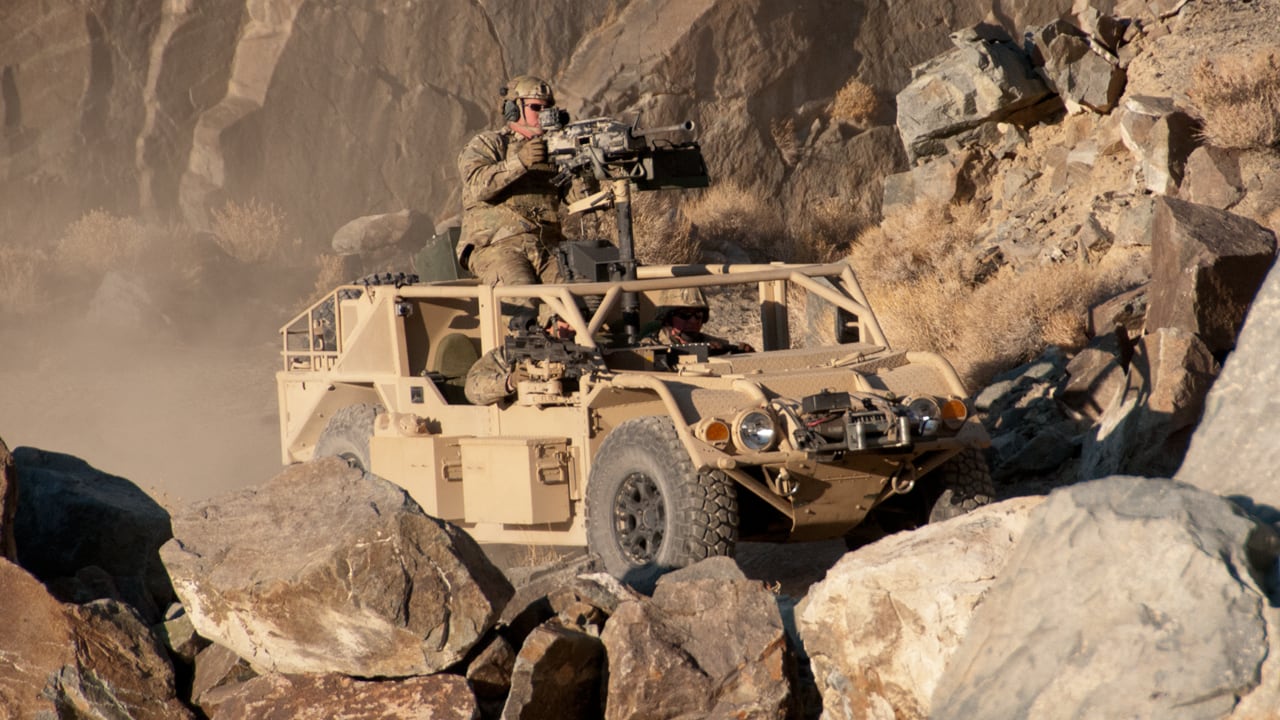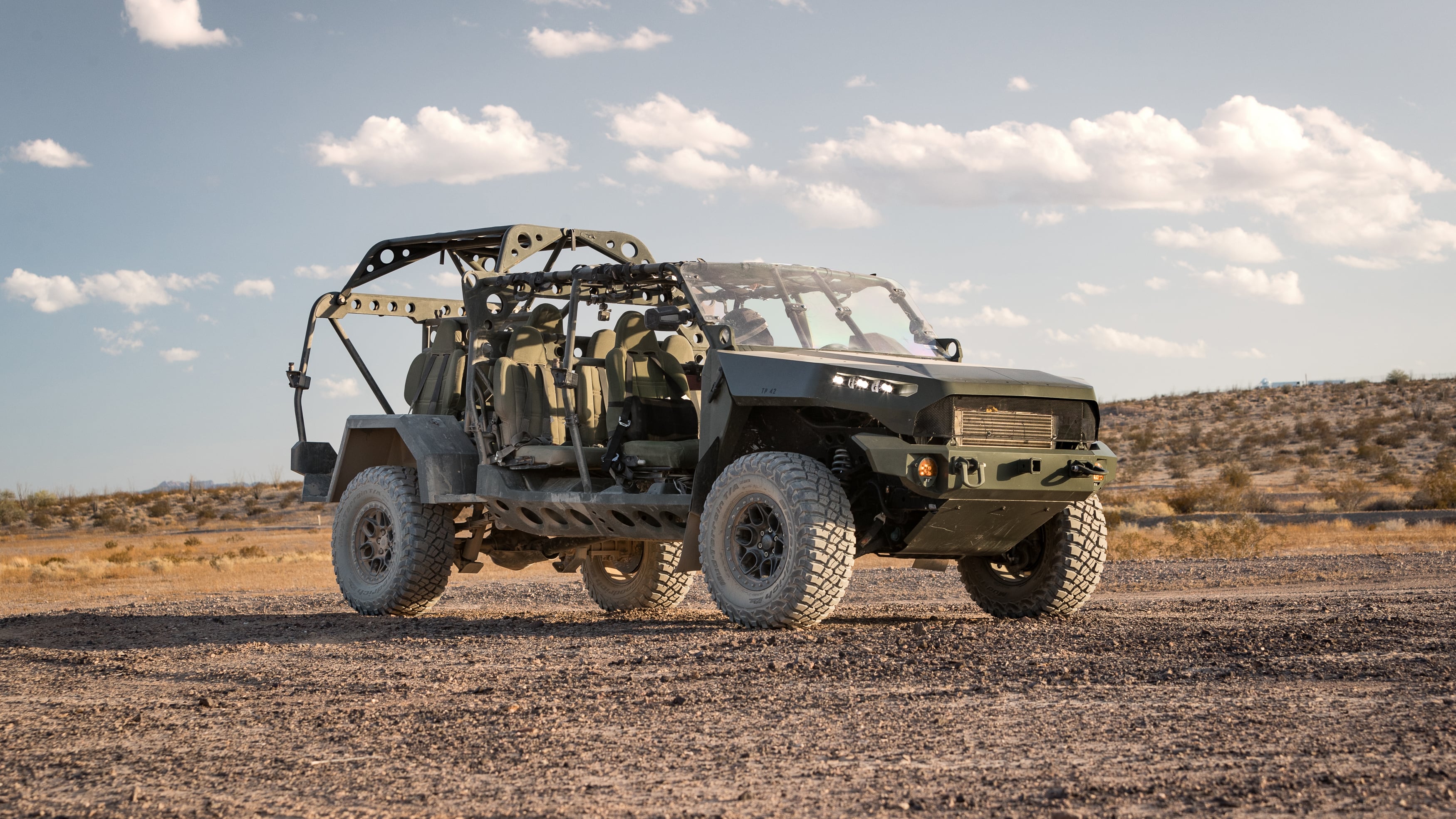WASHINGTON — The U.S. Army’s new Infantry Squad Vehicle is a cramped ride and offers limited protection from certain threats, according to a recent report from the Pentagon’s chief weapons tester, but it still meets the service’s requirements in tests and evaluations, the product lead told Defense News.
The ISV “key requirements are being met and we are increasing soldier operational readiness by providing an operationally relevant vehicle that can transport small tactical units to a dismount point faster and in better physical and mental condition for the fight,” said Steven Herrick, the Army’s product lead for ground mobility vehicles within the Program Executive Office Combat Support and Combat Service Support.
The vehicle was designed for easy transport to operational environments with the infantry’s current rotary and fixed-wing transport platforms. The key performance parameters required that the vehicle’s weight not exceed 5,000 pounds and that it fit inside a CH-47 Chinook cargo helicopter. Those requirements “force dimensional requirements only allowing the vehicle to be a certain height, width and length,” he said.
The requirements led to a vehicle that makes it hard for soldiers with all their gear needed for a 72-hour mission to comfortably fit inside and be able to access rucksacks on the move.
The Army assessed three vendors in developmental testing from December 2019 through January 2020. The service chose General Motors Defense to supply the vehicle to the force, with the company beating out an Oshkosh Defense and Flyer Defense team as well as an SAIC and Polaris team.
All offerings were capable of carrying a nine-soldier infantry squad with weapons and equipment during movement, the director of operational test and evaluation said in the report. But the Pentagon also noted the ISV “has not demonstrated the capability to carry the required mission equipment, supplies and water for a unit to sustain itself to cover a range of 300 miles within a 72-hour period.”
The Army, however, has assessed the ISV requirement and solution set is in alignment, Herrick said. The DOT&E report, he said, “indicates a desire to include more equipment than a standard nine-soldier squad would carry on a 72-hour mission.”
This lack of space, the report stated, “may create a logistics and operational burden” and might limit the type of missions and duration for ISVs.
The soldiers that participated in the touch point evaluating the vehicles were asked to bring their Advanced Combat Helmet and Improved Outer Tactical Vest with plates; individual weapon; night vision devices; and ruck with three days’ worth of supplies, Herrick said.
“All vendors’ ISVs are cramped and soldiers cannot reach, stow, and secure equipment as needed, degrading and slowing mission operations,” the report explained. During tests “soldiers on all ISVs could not readily access items in their rucksacks without stopping the movement, dismounting, and removing their rucksacks from the vehicle.”
The soldier touch point took into account soldier comfort, visibility and ability to execute the mission, Herrick said. This was all factored into the Army’s decision to choose GM Defense’s vehicle.
“Additionally, no current or planned combat or tactical vehicle allows access to rucksacks while moving to support operator safety,” Herrick noted. “Crew spaces on the ISV are designed to allow mission performance of specific duty tasks.”
RELATED

Units also lacked reliable communication capability, according to the report, using hand-held or manpack radios between 62 and 300 miles. The ISV does not have a mounted radio requirement. “Communication between the squad leader, soldiers, and the platoon leader was intermittent and not reliable,” the report found.
Because of the concept of the ISV providing an effective aid to insert soldiers into combat operations, the requirements support just what the soldier carries, so there is no mounted requirement yet, Herrick said. That requirement could be added as a growth capability later.
The DOT&E report also noted that the ISV doesn’t have an underbody and ballistic survivability requirement, which could mean the unit would be susceptible to certain threats, but the ISV’s speed as well as its small, low profile might help deal with those issues. Adding protection to the vehicle would sacrifice the speed the squad needs to rapidly inject itself into operations.
Overall, GM Defense’s vehicle had the highest reliability among the three vendors, demonstrating 585 mean miles between operational mission failures. The Army’s user requirement is 1,200 mean miles for that situation.
Herrick noted that reliability and maintainability testing was not scheduled or conducted by Army Test and Evaluation Command or the program office, so the calculations used in the DOT&E report were “not supported by traditional [reliability and maintainability] RAM elements, such as scoring conferences and time for the vendor to implement changes.”
The mileage accumulated and referenced in the report was “not meant to evaluate RAM by the Army, but rather to provide the program office and contractor an initial insight on the capability of the system over 500 miles,” Herrick added. The vehicle’s RAM testing is scheduled to begin this month, he added..
The service wasn’t able to evaluate every aspect of the vehicle before moving into production, but it plans to test the vehicle’s ability to be carried by a Chinook during its initial operational test and evaluation this year.
Now that the Army has chosen the GM Defense vehicle, it has already initiated developmental testing that will lead to an initial operational test and evaluation in August 2021 at Fort Bragg, North Carolina. That testing began in November 2020.
Jen Judson is an award-winning journalist covering land warfare for Defense News. She has also worked for Politico and Inside Defense. She holds a Master of Science degree in journalism from Boston University and a Bachelor of Arts degree from Kenyon College.




